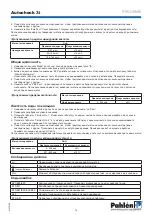
8
Autocheck 3i
MA70-10E
ENGLISH
23
CheckitDirect_Cl-pH-Cys-TA-CaH_1e 06/2009
GB
General notes
Method notes
Prior to measurement ensure that the sample is suitable for analysis (no major interferences)
•
and does not require any preparation i .e . pH adjustment, filtration etc .
Reagents are designed for use in chemical analysis only and should be kept well out of
•
the reach of children .
Ensure proper disposal of reagent solutions .
•
Material Safety Data Sheets: available on request
•
(Internet: www .tintometer .com)
Correct filling of the vial:
Correct position of the vial (Ø 24 mm):
23
CheckitDirect_Cl-pH-Cys-TA-CaH_1e 06/2009
GB
General notes
Method notes
Prior to measurement ensure that the sample is suitable for analysis (no major interferences)
•
and does not require any preparation i .e . pH adjustment, filtration etc .
Reagents are designed for use in chemical analysis only and should be kept well out of
•
the reach of children .
Ensure proper disposal of reagent solutions .
•
Material Safety Data Sheets: available on request
•
(Internet: www .tintometer .com)
Correct filling of the vial:
Correct position of the vial (Ø 24 mm):
2-3. Setting date and time
Confirm the menu selection by pressing the “Mode” button. The editable value will be visible for 2 seconds. The setting starts
with the year (yyyy) and the current value, followed by month (mm), day (dd), hour (hh) and minutes (mm). Set the tenths of
minutes first, then press the “!” button to continue to set the units.
Increase the value by pressing the “Mode” button, reduce the value by pressing the “Zero/Test” button. Continue to the next
setting by pressing the “!” button.
Once you have completed setting the minutes, press the “!” button. “IS SET” will be shown in the display and the photometer will
return to measurement mode.
4. Calibration
The photometer is factory calibrated, and we recommend that these values are followed and advise against changing the settings.
Zero point calibration
1. Select the required test by pressing the “Mode” button.
2. Take a clean measurement glass and fill with test water up to the 10 ml line. Screw on the cover.
3. Place the measurement glass in the meter, lining up the triangles on the measurement glass and the meter with each other.
4. Press the “Zero/Test” button. After approx. 8 seconds, “0.00” will be shown in the display.
The zero point calibration is saved in the instrument memory as long as Autocheck remains switched on. A fresh zero point
calibration does not need to be carried out provided that the same water sample is used and the same criteria apply.
Chlorine test
In instances where there are high chlorine concentrations (above 6 ppm), the chlorine will bleach the indicator used in the test
to produce a misleading value. Dilute the water sample by 50% using normal tap water, follow the instructions below and double-
check the result in order to get an applicable value.
• Free chlorine with DPD tablet
Autocheck 3i has two free chlorine measurement ranges: CL6 and CL10.
For CL6, one DPD No.1 tablet is used for measurement range 0.01-6.0 mg/l. For CL10, one DPD No.1HR tablet is used for
measurement range 0.1-10 mg/l. The procedure for free chlorine measurement CL6 is specified below:
1. Select “CL6” on the display by repeatedly pressing the “Mode” button.
2. Carry out zero point calibration in accordance with points 1–4 above.
3. Once “0.00” is shown in the display, remove the measurement glass from the meter and drop in a test tablet marked DPD
No.1 straight from its foil wrapper (without touching the tablet itself).
Using the crushing rod, crush and stir the tablet until it has been completely dissolved. Screw on the cover.
4. Place the measurement glass in the meter with the triangles lined up with each other.
5. Press the “Zero/Test” button. After approx. 3 seconds, the result will be shown in the display in ppm (mg/l) of free chlorine.
• Total chlorine using DPD tablet
6. Remove the measurement glass from the meter and place a test tablet marked DPD No.3 straight from its foil wrapper (with-
out touching the tablet itself) in the already coloured sample.
Crush and stir the tablet until it has been completely dissolved. Screw on the cover.
7. Place the measurement glass in the meter with the triangles lined up with each other. Wait 2 minutes for a colour reaction.
8. Press the “Zero/Test” button. After approx. 3 seconds, the result will be shown in the display in ppm (mg/l) of total chlorine.
Once the test has been completed, clean the measurement glass, cover and crushing rod under running tap water using
the brush.
• Tolerances, chlorine measurement using DPD tablet
Test method
CL6, measurement range 0.01–6.0 mg/l
CL10, measurement range 0.1–10.0 mg/l
Measurement range
Tolerance
Measurement range
Tolerance
Chlorine
0–1 mg/l
±0.05 mg/l
0–2 mg/l
±0.1 mg/l
1–2 mg/l
±0.10 mg/l
2–4 mg/l
±0.3 mg/l
2–3 mg/l
±0.20 mg/l
4–8 mg/l
±0.4 mg/l
3–4 mg/l
±0.30 mg/l
8–10 mg/l
±0.5 mg/l
4–6 mg/l
±0.40 mg/l
—
—
Summary of Contents for Autocheck 3i
Page 2: ......














